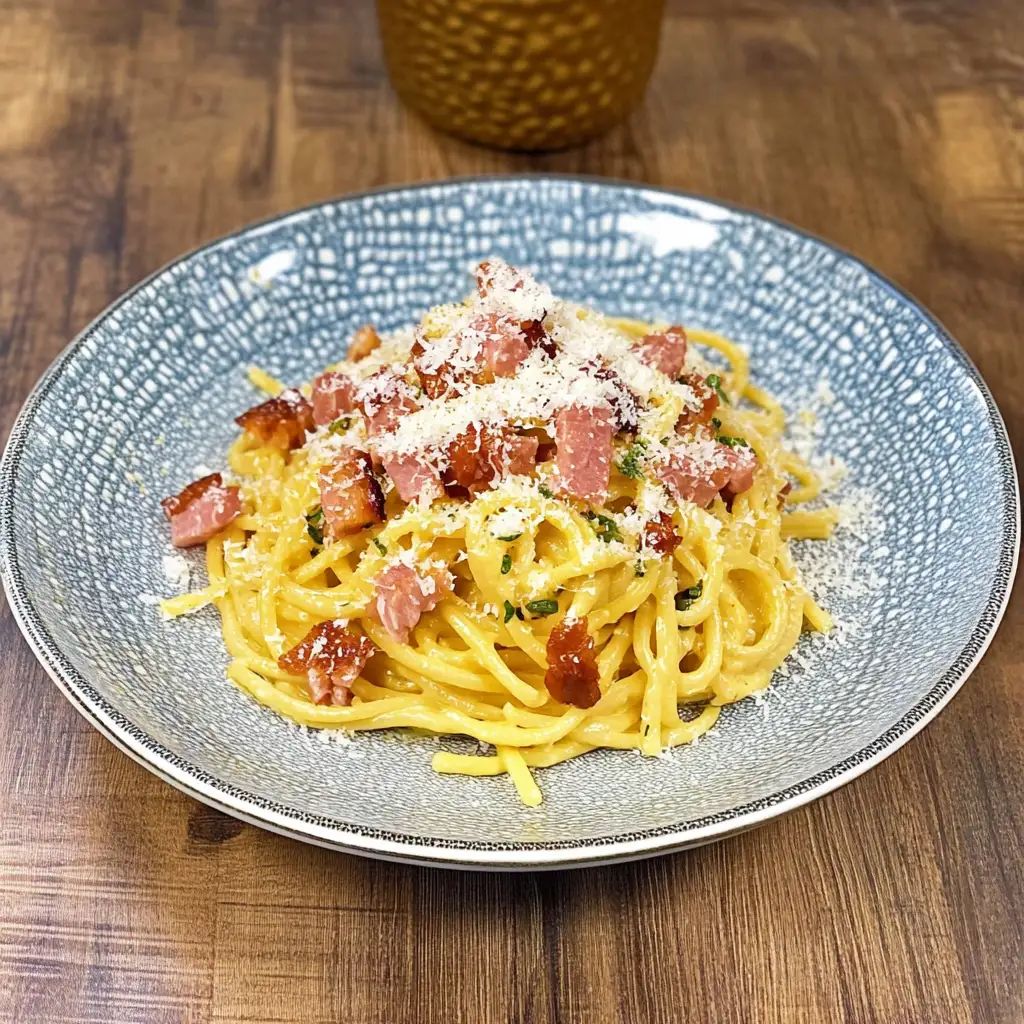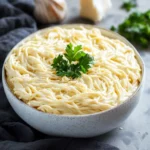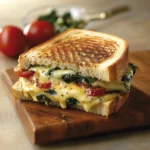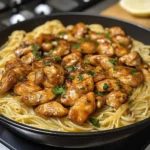Description of this recipe
This Spaghetti Carbonara recipe is a culinary journey to the heart of Italy. Authentic and rich, it’s a symphony of flavors, featuring the perfect balance of creamy egg yolks, sharp Pecorino Romano and Parmigiano Reggiano cheeses, crispy guanciale, and a generous dose of freshly cracked black pepper. Unlike many modern interpretations, this recipe sticks to the traditional Roman way, using no cream, ensuring a genuine taste of Italy in every bite. This dish is a testament to the fact that sometimes, the simplest recipes are the most satisfying.
Why you will love this recipe
You will fall in love with this Spaghetti Carbonara because it’s a quick, easy, and deeply satisfying meal that delivers an explosion of flavor with every forkful. The richness of the egg yolks combined with the salty, crispy guanciale and the sharp cheeses creates a sauce that is both luxurious and comforting. This recipe is perfect for a weeknight dinner when you crave something special but don’t have a lot of time. It’s also an impressive dish to serve to guests, showcasing your culinary skills and your appreciation for authentic Italian cuisine. But more than anything, you’ll love it because it’s a true taste of Italy, bringing the flavors of Rome to your own kitchen. It’s a dish that’s been perfected over generations, and one that you’ll want to make again and again. The simplicity of the ingredients allows the quality of each element to shine, making it a truly unforgettable meal. The absence of cream keeps it light yet indulgent, making it a classic dish that will never go out of style.
Ingredients:
PASTA
- 200g Spaghetti (or other long pasta like bucatini or linguine)
AMATRICE’S GUANCIALE
- 100g Guanciale, cut into strips
EGGS
- 2 Egg Yolks
- 1 Whole Egg
CHEESE
- 50g Pecorino Romano Cheese, finely grated
- 50g Parmigiano Reggiano Cheese, finely grated
SEASONING
- Freshly Cracked Black Pepper, to taste
- Salt, to taste
Preparation:
Step 1: Prepare the Guanciale: Start by slicing the guanciale into strips about ¼ inch thick. The key here is to have even pieces so that they cook uniformly. This step is crucial as the rendered fat from the guanciale will form the base of the flavorful sauce.
Step 2: Cook the Guanciale: Place the guanciale strips in a large skillet over medium-low heat. Cook slowly until the guanciale is crispy and golden brown, rendering its fat. This should take about 5–8 minutes. Be patient and avoid high heat to prevent burning. Once crispy, transfer the guanciale to a plate lined with paper towels, leaving the rendered fat in the pan. This rendered fat is liquid gold and is essential for the carbonara’s unique flavor.
Step 3: Prepare the Egg Mixture: In a mixing bowl, combine the egg yolks, whole egg, finely grated Pecorino Romano, and Parmigiano Reggiano. Add a generous amount of freshly cracked black pepper. Whisk vigorously until the mixture is smooth and creamy. The consistency should be thick but pourable. This mixture is the soul of the carbonara, so make sure it is well combined.
Step 4: Cook the Pasta: Bring a large pot of salted water to a rolling boil. Add the spaghetti and cook until al dente, following the package instructions. Typically, this will be about 8–10 minutes, but it’s important to taste the pasta to ensure it’s cooked to your liking.
Step 5: Reserve Pasta Water: Before draining the pasta, reserve about ½ cup of the pasta water. This starchy water is crucial for achieving the perfect creamy consistency in the sauce.
Step 6: Combine Pasta and Sauce: Turn off the heat under the skillet with the guanciale fat. Immediately add the hot, drained pasta to the pan and toss to coat it evenly with the fat. Quickly pour the egg and cheese mixture over the pasta, stirring constantly to prevent the eggs from scrambling. The heat from the pasta and pan will gently cook the eggs, creating a creamy, glossy sauce. Add a few tablespoons of the reserved pasta water to thin the sauce as needed and make it silky smooth. The key here is to work quickly and maintain a constant stirring motion. If the sauce seems too runny, you can briefly return the pan to very low heat and stir for about 30–60 seconds, but be extremely careful not to overcook the eggs.
Step 7: Serve Immediately: Plate the carbonara immediately. Garnish with extra Pecorino Romano cheese and a generous sprinkle of freshly cracked black pepper. The dish is best enjoyed hot and fresh, so serve without delay.
COOKING Rating:
- Ease of Cooking: Intermediate (requires some technique and timing)
- Taste: Exquisite
- Presentation: Elegant
Serving Suggestions:
- Serve immediately after preparation for the best flavor and texture.
- Pair with a crisp, dry white wine like a Pinot Grigio or a Vermentino.
- A simple green salad with a light vinaigrette can complement the richness of the carbonara.
- Crusty bread is perfect for soaking up any remaining sauce on the plate.
- For an extra touch, garnish with a sprig of fresh parsley.
Tips:
- Use high-quality ingredients, especially the guanciale and cheeses, as they are the stars of the dish.
- Ensure the pasta is cooked al dente; it should have a slight bite to it.
- Work quickly when combining the pasta and the sauce to prevent the eggs from scrambling.
- If the sauce becomes too thick, add more reserved pasta water, a tablespoon at a time, until you reach the desired consistency.
- Don’t be tempted to add cream! The authentic carbonara relies on the eggs and cheese for its creamy texture.
- Freshly cracked black pepper is essential for the flavor; avoid using pre-ground pepper.
- If you can’t find guanciale, pancetta can be used as a substitute, but the flavor will be slightly different.
- For a vegetarian option, consider adding sautéed mushrooms or zucchini for added texture and flavor.
- Taste and adjust the seasoning as needed. The Pecorino Romano is quite salty, so you may not need to add much additional salt.
- Leftovers can be stored in the refrigerator, but the sauce may thicken. Reheat gently with a splash of milk or pasta water to restore the creamy consistency.
Prep Time:
10 minutes
Cook Time:
15 minutes
Total Time:
25 minutes
Nutritional Information:
(per serving, approximate)
- Calories: 650 kcal
- Protein: 30g
- Sodium: 800mg
Conclusion
Spaghetti Carbonara is more than just a meal; it’s an experience. With its rich flavors and simple ingredients, it captures the essence of Italian cuisine. This authentic recipe, passed down through generations, is a must-try for any food lover. Whether you’re cooking for a special occasion or simply craving a taste of Italy, this Spaghetti Carbonara will not disappoint. The key to success lies in the quality of the ingredients and the technique of combining them to create a creamy, flavorful sauce. So gather your ingredients, follow the steps, and transport yourself to Rome with every delicious bite. Buon appetito!
Questions and Answers about this recipe
Q1: Can I use cream in this recipe?
A: No, authentic Spaghetti Carbonara does not include cream. The creaminess comes from the combination of egg yolks, cheese, and pasta water. Adding cream changes the flavor profile and makes it a different dish altogether.
Q2: What if I can’t find guanciale? Can I use bacon instead?
A: While guanciale is the traditional ingredient, pancetta is a more acceptable substitute than bacon. Bacon has a smoky flavor that will alter the taste of the carbonara. Pancetta offers a similar, though less intense, flavor profile to guanciale.
Q3: How do I prevent the eggs from scrambling when I add them to the pasta?
A: The key is to work quickly and ensure the heat is low. Turn off the heat under the skillet before adding the egg mixture, and stir constantly to create a creamy sauce. The residual heat from the pasta and pan will cook the eggs gently without scrambling them. Adding a little pasta water can also help regulate the temperature.
Q4: Can I make this recipe ahead of time?
A: Spaghetti Carbonara is best served immediately after preparation. The sauce can thicken and the pasta can become sticky if made ahead of time. If you need to prep in advance, you can cook the guanciale and prepare the egg mixture ahead of time, but combine everything just before serving.
Q5: What kind of cheese is best for carbonara?
A: The best cheeses for Spaghetti Carbonara are Pecorino Romano and Parmigiano Reggiano. Pecorino Romano has a sharper, saltier flavor, while Parmigiano Reggiano is more nutty and complex. Using a combination of both provides the perfect balance of flavors for an authentic carbonara.




